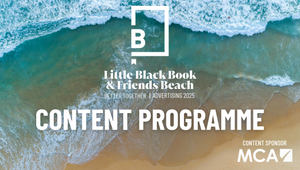
LePub and Heineken’s Work “Starts With Art” Science Comes Later

A compelling conversation unfolded between Heineken and LePub, moderated by LBB’s Matt Cooper, at LBB & Friends Beach. The panel underlined the importance of belief – in creativity, in relationships rooted in trust, and in the power of brands to drive cultural change – and how the two companies built an enviable relationship.
LePub, described by Nabil as “an extension of the Heineken family,” is a creative agency unlike most. It’s a global network, but with deep local roots. “When I opened the agency in Mexico, I hired only Mexicans,” said Bruno. “Maybe with international experience, but very rooted in the local culture. That’s what makes the difference.” For LePub, local nuance isn’t a trend – it’s the model.
That local understanding feeds directly into one of the session’s most resonant themes: tone of voice. “Today, the difference between one brand and another isn’t only the big idea, it’s the tone,” Bruno explained. “Heineken has a very precise tone of voice. It’s not preachy. It’s witty. It’s human.”
For a brand with such global reach, that’s no small achievement. And it's essential to the mission. “Heineken champions social life,” Nabil said. “It’s relevant to people’s wellbeing. It’s essential to our partners, and it’s congruent with our company’s purpose – brewing the joy of togetherness.”
That idea – togetherness – underpinned much of the conversation. From their campaigns to their working relationship, Heineken and LePub operate on a shared set of values. “LePub is not really an external agency,” Nabil assured. “It’s more of a family, with shared ambitions and values. Both sides want to build the brand in a sustained and profitable way. Even if you look at the name, LePub – it’s a mesh between Publicis and the home of Heineken! It’s a symbol of shared belief.”
That trust manifests in fast, informal communications – WhatsApp messages, short calls – and a shared commitment to agility. “We’re working on 26 projects together this year,” said Bertelli. “Sometimes I talk to Nabil more than my wife.”
But while the cadence may be fast and informal, the work is deeply considered. One of the major campaigns discussed was Heineken’s ongoing effort to combat digital overload – an issue the brand has positioned as a core barrier to modern social life. One piece, described by Nabil as ‘The Heineken Point of View’, shows how people spend six hours a day on screens, equating to 80 days a year. “It’s not about demonising tech,” Nabil said. “It’s about saying: maybe get off your socials a little, so you can actually be social.”
Don’t get him wrong, data plays a role, he promises, especially in helping the team identify trends and course-correct work. But it’s not the starting point. “The work starts with art,” Nabil added. “Then we might consider science.”
That intuitive approach has also helped surface creative that starts local but becomes global. One such example was the ‘Boring Phone’ campaign in Italy, which tackled the same digital detox theme and ultimately inspired broader campaigns across continents. “The world is flat,” said Nabil. “If something resonates, it travels.”
As the pair discussed the return of humour in advertising – something both see as a welcome shift – Bruno noted “ a moment where everything was heavy, emotional in a traditional way. But humour is back, and it’s great for our category.”
Craft and execution, they both stressed, are increasingly important as brands seek to premiumise and elevate their image. This is especially true as LePub and Heineken maintain flexibility at the local level to work with different production partners. “The detail matters,” said Bruno. “Because execution is tone. It’s how a brand feels.”
And what space does AI occupy in this tone and new world? Not as much as one might expect. Bruno was categorical: “AI still can’t replicate tone of voice. When you use AI to replicate reality, you’re cheating consumers.” Instead, he sees AI as a useful tool for small social formats – quick, contained experiments – but not as replacement for real, human insight.
One of Bruno’s sharpest insights came when asked about how sound is considered in brand strategy. “My approach is from literal to lateral,” he said. “The global strategy needs to be clear and precise, but that gives you freedom to explore different expressions. You come back at the end to make sure the tone is right.”
Ultimately, the panel offered a blueprint for how creative partnerships can thrive in an era of complexity and noise. “I have never seen a brand built consistently without this type of collaboration,” said Nabil, addressing CMOs hesitant to trust their agencies as partners. “It’s essential.”
That mutual respect – alongside a shared belief in the value of creativity to move business and culture – is what helped develop, as Matt concluded, “a beautiful relationship.”















